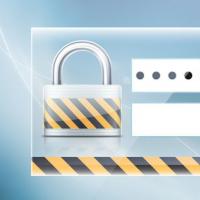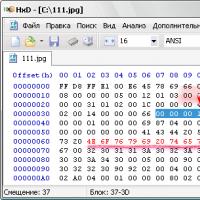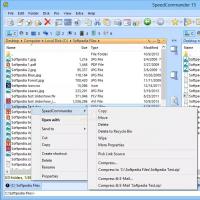Wireless network not connecting connection error. Windows could not connect to Wi-Fi: diagnostics and solution of the problem. Roll back to the previous version of the driver
To solve the error "Windows cannot connect to (name of Wi-Fi network)", you need to go to Manage wireless networks in the Control Panel, delete the problem wireless network, and then reconnect to it.
An error will also occur if the password for the router is entered incorrectly. Since the Wi-Fi password is rarely entered, it is often forgotten. You should check the correctness of the password, the layout and the CapsLock key, and, if necessary, change the password for the network in the settings of the router.
The steps in this article are described using the example of Windows 7, since the error appears in the 7 version of Windows more often than in XP, 8 (8.1) or the 10th version. To fix the error in other versions of Windows, you need to do the same, but some names and menu locations may differ.
Causes of the error, checking the Internet and router
If Internet access worked stably, and then the device stopped connecting, you should check the performance of Wi-Fi in general. You need to connect to the network from another device. It is desirable from one where the Wi-Fi password has already been saved in order to prevent mistakes when entering the password.
A laptop or other device that is having problems should try connecting to a different Wi-Fi network. These simple steps will allow you to find out if Internet access works at all, the problem affects one device or the router / network as a whole.
If a router is hacked or an accident occurs, there will be no access line from any device. If other devices are working fine, you should deal with a specific laptop: check for viruses, update network drivers, view Windows logs. A much simpler option is to try to remedy the situation using one of the tips below.
Removing the wireless network and reconnecting to Wi-Fi:
This completes the process of removing the wireless connection. To reconnect, just select the desired Wi-Fi network in the general list of available networks. Since the connection settings have been reset, you will need to re-enter the password when connecting.
Enabling the wireless adapter
If the connection is still not established, an error appears, or the network is not searched for at all, you need to consistently check the performance of the components responsible for connecting via the Wi-Fi network. The first step is to check if the wireless adapter is turned on at all.
Turning the Wi-Fi wireless adapter on and off:
- Go to the Start menu -> Control Panel -> Network and Internet ->
- In the left menu, select Change adapter settings.
- In the window that opens, the picture next to the inscription "Wireless network connection" should be colored. If the image is gray / black-white and says Disabled, then the adapter is not working. Right-click on the Wireless Network Connection icon and select Enable.
Only users with administrator rights can enable or disable the network adapter in the Control Panel. If the adapter was turned off, after turning it on, you should try to connect to Wi-Fi again. If the signal is poor, it may take 1-2 minutes to connect to the network.
You should also check if the wireless module is disabled by the hotkey combination. On most ASUS models, Wi-Fi is turned on and off by pressing the Fn + F2 key combination. Lenovo, HP, Acer and other manufacturers may have their hot combinations. A wireless on / off button is usually labeled or marked with a corresponding icon. If the Wi-Fi adapter was turned on and the problem persists, move on.
Checking Wi-Fi adapter drivers
If a red cross is displayed on the Internet connection icon in the tray, you should check if the Wi-Fi adapter is turned on and if the device driver is in place. Drivers may crash during a system update, installation of third-party software, as a result of incompatibility with other software.
To check if the network drivers are installed correctly, you need (instructions for Windows 7):
- Right-click on the My Computer icon.
- Click the Properties button.
- In the menu on the left side of the screen, go to the Device Manager tab.
- Find the line Network adapters and click on it to expand the list of devices.
- Find the adapter responsible for the wireless network. It may be called the Wireless Network Adapter (the name may differ, but the essence remains).
- If the adapter is detected and working properly, you need to right-click on it and go to the Properties tab.
- Another window will open. At the bottom of the screen, in the Device Status window, it should say Device is working normally.
If the indicated inscription is present, then the drivers for the Wi-Fi adapter are installed and function correctly. Sometimes it happens that there is an unrecognized device in the list of devices, the status is different from "The device is working normally", or the Wireless Network Adapter is not present at all in the Device Manager list. This means that for some reason the driver has crashed. You need to go to the official website of your laptop manufacturer (HP, Lenovo, Asus, Acer) and download the drivers for the Wi-Fi adapter. After installing the drivers, it is advisable to restart your computer before trying to reconnect.
Setting up a wireless connection
If everything is in order with the drivers, the adapter is turned on and reconnecting to Wi-Fi does not solve the problem, you should check the more precise wireless connection settings, as well as the router settings. You can view the wireless connection settings in the Network and Sharing Center.
To check if the wireless settings are correct:
- Open the Start menu, open the Control Panel.
- Go to the Network and Internet section -> Network and Sharing Center.
- In the left menu, click on the link Change adapter settings.
- Find the Wireless Network icon, right-click on it and select Properties.
- In the window that opens, in the "Network" tab, you need to find Internet Protocol version 4 (TCP / IPv4), click on it, then click on the Properties button.
- In the window that opens, dots should be set in the "Obtain an IP address automatically" and "Obtain DNS server address automatically" checkboxes.
If all the parameters were set exactly like this, you need to click "OK" and try to connect to the network. If you still cannot do this, you can try deleting the wireless network again. This action is safe and is necessary to reset the settings, which are set again when you try to connect again. If your laptop still can't connect to Wi-Fi, you can try one of the tips below.
Actions when nothing else helps:
- View the Windows event log for errors. To do this, you need to find the My Computer shortcut, right-click on it and select Manage, then find the Event Viewer section in the left menu and go to it. Open the Windows Logs folder -> System. There are many system events, so it may take some time for the document to open. You need to find events related to the wireless connection and marked with a yellow or red icon. When opening an event, you can find out additional information and an error code, which will make it easier to find a solution to the problem on the Internet.
- Temporarily disable Windows Firewall and anti-virus programs - in rare cases, they can block the connection.
- Restart your computer in Safe Mode with network driver support. Safe mode is launched by pressing the F8 key during Windows startup. If the connection is normally established in this mode, the cause of the error may be the activity of the installed software or virus activity.
- Go to the router settings and check if the device's MAC address is under the filter. Such a development of events is quite likely as a result of a hacked router, especially if standard login data such as admin and a basic password (or without it at all) remained for access to it.
- Click Start -> Run -> cmd.exe to launch the command line. Enter the sfc / scannow command and press Enter to start the system self-test. It will result in the recovery of damaged system files and drivers, which may be necessary for the Wi-Fi connection to work.
- Try changing the network name (SSID) in the router settings. After that, Windows devices will think that this is a new network, and re-register the settings for it upon connection.
- Try to find an answer in Microsoft Help for Windows 7, 8, and 8.1 (https://support.microsoft.com/en-us/help/15287/) and for Windows 10 (https://support.microsoft.com/en -ru / help / 17220 /).
In the settings of the router, you can reset the password and make sure that the desired security type is set. After that, it will not help to restart the router again and try to connect via Wi-Fi.
This is how a laptop (netbook, etc.) works with a Wi-Fi network, it would seem, and no questions asked. And one day you turn it on - and an error occurs: "Windows could not connect to Wi-Fi ...". What to do?
This was actually the case with my home laptop. In this article I want to tell you how you can eliminate this error (besides, as practice shows, this error is quite common).
The most common reasons:
1. Lack of drivers.
2. The settings of the router are lost (or changed).
3. Antivirus programs and firewalls.
4. Conflict of programs and drivers.
And now how to eliminate them.
Resolving the error "Windows could not connect to the Wi-Fi network"
1) Configuring Windows OS (for example, Windows 7, in Windows 8 - the same).
If you still get an error stating that it is not possible to connect to the network (as in the picture below), click on the "troubleshoot" button (I know that many are very skeptical about it (I myself treated it the same way until it helped restore a couple of times network)).

If the diagnostics did not help, go to the "Network and Sharing Center" (to enter this section, just right-click on the network icon next to the clock).


Now we just delete our wireless network, to which Windows cannot connect in any way (by the way, you will have your own network name, in my case it is "Autoto").

We are again trying to connect to the Wi-Fi network that we deleted in the previous step.

In my case, Windows was able to connect to the network, and no questions asked. The reason turned out to be trivial: one "friend" changed the password in the router settings, and in Windows, in the network connection settings, the old password was saved ...
![]()
2) Setting up a Wi-Fi network in the router
After checking your Windows wireless settings, the second thing to do is check your router settings. In 50% of cases, it is they who are to blame: either they got lost (which could happen, for example, during a power outage), or someone changed them ...
Because you could not access the Wi-Fi network from a laptop, then you need to configure a Wi-Fi connection from a computer that is connected to the router using a cable (twisted pair).
In order not to repeat myself, here is a good article on how to enter the router settings. If you can't log in, I recommend that you familiarize yourself with this:
In the router settings we are interested in the "Wireless" section (if in Russian, then the Wi-Fi settings).
For example, in TP-link routers, this section looks like this:

by the way, in some cases it may be necessary to reset the router (router). On its body there is a special button for this. Hold it and hold it for 10-15 seconds.
Task: change the password and try to configure a wireless connection in Windows (see paragraph 1 of this article).
3) Updating drivers
The absence of drivers (however, as well as installing drivers that do not match the hardware) can cause much more serious errors and failures. Therefore, after checking the settings of the router and network connection in Windows, you need to check the drivers for the network adapter.
How to do it?
1. The easiest and fastest option (in my opinion) is to download the DriverPack Solution package (in more detail about it -.

2. Manually remove all drivers for your adapter (which were installed earlier), and then download from the official website of your laptop / netbook manufacturer. I think you can figure out the download without me, but you can find out how to remove any driver from the system here:
4) Configuring startup and disabling antivirus
Antiviruses and firewalls (with certain settings) can block all network connections, ostensibly to protect you from dangerous threats. Therefore, the easiest option is to simply disable or delete them for the duration of the settings.
Regarding autoloading: for the duration of the setup, it is also advisable to remove all programs that are automatically loaded with Windows. To do this, press the "Win + R" button combination (valid in Windows 7/8).
Then we enter the command in the "open" line: msconfig


5) If all else fails ...
If Windows still cannot connect to the Wi-Fi network, you can try to open the command line and enter the following commands in sequence (enter the first command - press Enter, then the second and Enter again, etc.):
route -fipconfig / flushdnsnetsh int ip resetnetsh int ipv4 resetnetsh int tcp resetnetsh winsock reset
Thus, we will reset the parameters of the network adapter, routes, flush DNS and Winsock. After that, you need to restart your computer and reconfigure the network connection settings.
If you have anything to add, I would be very grateful. Good luck!
Today we are going to talk about how to get rid of the error related to network parameters. For example, on Windows 8 or 8.1, the error will look like this: "Unable to connect to this network."
In Windows 7, a slightly different error, how to fix it, I will write in the following articles. But now, I will tell you how to get rid of the error that appears in Windows 8 / 8.1 / 10. It appears when we try to connect to or if the network automatically tries to connect. In any case, there are no all reasons for this error, but the most common one is that an error appears due to a change in the wireless network settings, while the computer was already connected.
In other words, it looks like this: we have a computer running Windows 8 or Windows 10, it is connected to a wireless network and everything works fine. The next time you turn on your computer and try to connect to Wi-Fi, it starts "Checking Network Requirements", and then the error “Unable to connect to this network” appears.
If someone, and maybe you yourself, changed the networks on the router, for example, the password, etc. The settings saved on the computer itself no longer coincide with the settings on the router, then an error appears.
Solving the network problem
The solution to the problem is very simple, you just need to click “Forget this network” and reconnect to it. In Windows 8, this is done as follows:
To get started, click on the network icon, a panel should open on the right, where all your Wi-Fi networks and, possibly, other people's networks are visible. Right-click on the problem network and click on the item "Forget this web".

Now open this notification panel again and connect to the same network, while entering the password, if you have set it.
If everything went well, you will see an inscription opposite your network "Connected".
It is possible that when you try to connect, this error appears again, then try setting the router parameters in this way when everything worked, or restart it, and also restart your computer and check it for viruses.
If you do not understand what needs to be done, write in the comments and I will help you as much as I can.
Quite a common problem among Windows users when the computer cannot connect to the Wi-Fi network. There may be several reasons for this problem. And in this article we will try to cover them all.
There are enough reasons why the computer cannot connect to the wireless network. Below we will consider the most common reasons in descending order.

Reason 1: incorrect entry of the key from the wireless network
Oddly enough, but users have problems connecting to Wi-Fi precisely because of the wrong password.
If you do not remember exactly what your Wi-Fi password looks like, then this information can be obtained by referring to the parameters of the router. To do this, launch any browser and enter in the address bar 192.168.1.1 (less often 192.168.0.1 ) and press the Enter key. Enter the login password to enter the parameters of the router (it is standardly used as a login and password "Admin") and then head to the section "Wireless network" - "Security key"(name may be different) and view the current Wi-Fi password information.
When entering your password, pay attention to the keyboard layout and the activity of the Caps Lock key.
Reason 2: the router is frozen
If the computer used to quietly connect to the wireless network, and then abruptly lost the connection, try restarting the router. To do this, turn it off for a couple of minutes, turn it on and wait until it is fully loaded. Then check your Wi-Fi connectivity.
Reason 3: "glitch" in the Wi-Fi adapter
Try turning off and on the Wi-Fi adapter. If you are the owner of a laptop, then the keyboard shortcut is usually responsible for it. Fn + F2 .
Reason 4: incorrect operation of drivers
Click on the menu in Windows Explorer "My computer" RMB and select the button "Properties" .
On the left side of the window that appears, select the option "Device Manager" .
Expand the tab "Network devices"... If you see an exclamation mark next to your Wi-Fi adapter, then the drivers need to be updated. To do this, go to the official website of the laptop manufacturer and download the necessary drivers specifically for your device model. Install the drivers on the laptop, and then restart it.
Reason 5: in the settings of the router there is a limit on the number of connected devices
Again, you need to check the settings of the router to make sure that the number is set in the settings for a sufficient number of connected devices.
After entering the router settings, go to the section "Wireless network" and check the required item. If necessary, expand the number of connected devices and save the settings.
Reason 6: a MAC address filter is set in the router settings
It can be assumed that for some reason the MAC address of your device has been blacklisted, which will block the W-Fi connection. Often this problem occurs when a router is hacked.
Go to the router settings and select the section "MAC Address Filter" or "MAC-Filtering" and check if any devices are listed there. If they are there, they can be removed from the list. It will also be useful to change the security key of the wireless network, as well as the password for entering the settings of the router.
Reason 7: incorrect settings on the computer
Open up "Control Panel" and go to section "Network and Sharing Center" .
Click on the button with parameters in the left pane of the window.
Click on your RMB connection and go to item "Properties" .
Wi-Fi is ubiquitous. It is available in almost all public places and parks, and some private apartments and households have begun to equip Wi-Fi. Manufacturers install such a module in many electronic devices.
Now, not a single computer can do without it, whether it is a stationary or a laptop, and there is no need to remind about phones, TVs and tablets, because even some watches already have a built-in Wi-Fi adapter.
For sure, very soon this function will be present in kettles, door locks, refrigerators, coffee makers, microwave ovens and even air conditioners.
From entertainment, educational and communication uses, wireless connectivity has rapidly grown into an absolute must for everyone. But what to do when there are difficulties with the connection?
Below is a guide on how to quickly and effectively eliminate connection difficulties for various types of electronic gadgets.
Solving Internet Connection Problems
If the user was unable to connect to Wi-Fi from his electronic device, then first of all it is necessary to check the presence of the Internet at the router itself, which broadcasts the wireless signal.
To do this, you need to connect a computer to the router via a wire and see if it will connect to the global network. If not, then difficulties arose in the incorrect settings of the device or on the side of the company of the communication service provider.
If the result is positive, that is, in the case when the PC has access to the Internet via a cable connection, then proceed to the wireless network settings.
Solution
First, make sure that the LED with the "Wi-Fi" icon on the router is active, and also make sure that the Wi-Fi module is turned on in the gadget from which you plan to connect to the network.
If the router indicator is off, you need to open the device's web configurator (you can access it through a browser, and the address is indicated in the device's documentation or on a sticker on the bottom of the device's case) and turn on the network.
In the case when there is no communication activity in the PC or in the mobile device, then reboot the device. When using a laptop, the module is already activated in it by default.
However, the device may have been turned off by some other user to conserve battery power. Then on the keyboard you should find a key with a characteristic image. For example, on "ASUS" you need to hold down the "FN" button and click on "F2".
 On different laptops, switching on is carried out in different ways, for example, on "Acer" and "Lenovo" there are separate switches located on one of the ends of the mobile PC.
On different laptops, switching on is carried out in different ways, for example, on "Acer" and "Lenovo" there are separate switches located on one of the ends of the mobile PC.
 Such a toggle switch just needs to be set to the "On / On" position and the adapter is activated.
Such a toggle switch just needs to be set to the "On / On" position and the adapter is activated.
Then, after waiting for the router to boot completely, you need to restart your laptop or gadget. An exception can be made only for Vaio laptops from Sony, since they will be connected automatically, but even for these machines, an extra reboot will not hurt.
Activating Wi-Fi in a computer using the operating system
On a Windows PC, you need to do the following:


 When the execution of the described activities did not lead to success and the computer still does not connect to the Internet, then you will have to move on to studying the next paragraphs of this manual.
When the execution of the described activities did not lead to success and the computer still does not connect to the Internet, then you will have to move on to studying the next paragraphs of this manual.
Software problem
A common problem that causes such a problem is incorrectly installed drivers or their absence.
At the same time, the name of the module is not displayed in the "Device Manager", and it can also be marked with a "!" 
What to do when Wi-Fi module software is not installed?
You only need to complete a few of the following steps:
- Writing out the exact name of the laptop model, that is, it is not easy, for example, "Samsung", and from the documentation or from the packaging of the device, find out its full name. In the case of using a stationary PC, in the same way find out the model of the Wi-Fi adapter itself;
- Log in to the equipment manufacturer's Internet resource and download software for your device;
- The software is installed like any other program; you just need to follow the requirements of the installation wizard. After the procedure, be sure to restart the PC. You can also install it through the "Device Manager", but first you need to extract the driver distribution to a separate directory in the PC's memory. Then in the column "Driver" click "Update" and click "Search on this computer". Next, show the program the location of the directory with the distribution kit and the OS will install the software itself.
If access does not appear, even though the device now sees the network but cannot connect, then the mode is probably set incorrectly in the router's web configurator.
Checking router settings
Open the Wireless tab in the web configurator and set the Mixed mode. In the D-Link instrument interface, this standard is displayed as follows:
In the settings of Zixel devices, you need to set the template, as highlighted in the screenshot below:
 In the case when it is still impossible to access the Internet, then most likely at this stage the computer already perfectly sees the wireless network, but does not connect.
In the case when it is still impossible to access the Internet, then most likely at this stage the computer already perfectly sees the wireless network, but does not connect.
To remedy the situation, you just need to follow the measures described in the next paragraph of this instruction.
Debugging the connection
In such a situation, the "Network and Sharing Center" will display the following picture.
 It is necessary to perform the following actions:
It is necessary to perform the following actions:

1 scenario:
 This means that the problem is in the Wi-Fi module, which cannot receive an "IP" address, or it is simply not specified correctly.
This means that the problem is in the Wi-Fi module, which cannot receive an "IP" address, or it is simply not specified correctly.
To fix the problem, you need to do the following:

Scenario 2:
A menu like the following appears:
 This means that the network parameters were entered incorrectly in the web-based interface of the router, or the wrong DNS addresses were specified.
This means that the network parameters were entered incorrectly in the web-based interface of the router, or the wrong DNS addresses were specified.
To fix the problem, you should do this:

If logging in again is problematic, the only option left is to simply remove the restrictions in the router's web configurator.
Difficulty connecting to Wi-Fi on an Android device
Before starting to perform the measures described below, it is recommended to make sure that the broadcast access point is working properly, and for this, connect to it from another device, for example, from a laptop. It is possible that the problem is not with Android, but with the translator's settings.
 Often, an Android gadget normally recognizes a wireless network, but cannot make a connection.
Often, an Android gadget normally recognizes a wireless network, but cannot make a connection.
This often happens through the fault of the owner of the mobile device, since there is a high probability of an error when entering the access key to the protected network. It is necessary to carefully check each character of the code and the difficulties will quickly disappear.
 The next most popular reason is that the phone or tablet does not support the kind of protection that is specified in the router's web configurator.
The next most popular reason is that the phone or tablet does not support the kind of protection that is specified in the router's web configurator.
You just need to change this type by entering the device settings interface, after this adjustment, the connection will occur without problems. 
Application of third-party applications
Many utilities are available for free use in the Google Play Store, designed to solve all the difficulties that arise with connecting Android devices to Wi-Fi.

The application shows the state of the connection and all points available in the range. According to information from the developers, the utility is able to increase the signal reception power if it is weak or the translator is located too far away.
And also, and vice versa, to reduce the strength of Wi-Fi with an excessively strong signal, this is especially true when the device is in close proximity to the router.
To take advantage of the utility, you just need to install it, and then, after launching it, it will automatically fix all the problems and then work in the background, so, as a rule, users do not have any difficulties with the connection.
When is the cause of the firmware malfunction?
Sometimes, after installing a new version from a third-party developer in a gadget, connection problems appear. In this case, the best option would be to reset the device parameters to the factory state.
Analysis of the characteristics of a wireless signal translator
If the filter for "MAC" addresses is activated in the web configurator, then the gadget can simply be on the list of unwanted clients. In this case, simply disabling this filter will help, or you will need to exclude the device from the black list. For this purpose, the MAC address of the device can be found by entering the settings of a smartphone or tablet.
The gadget from "Apple" does not want to connect to Wi-Fi
Often, iOS devices, when trying to connect to the module, start to write: "Failed to connect to the network." Why Apple has not developed guidelines on how to deal with such situations is still unclear. Below is a homemade technique to fix this error.
 Only a few of the following steps need to be taken:
Only a few of the following steps need to be taken:

This technique does an excellent job of eliminating the difficulties that arise when connecting, however, it is not entirely convenient for users due to the removal of saved network access codes. Therefore, at first, you can try the methods described below, although they are not as effective.
Restarting iPhone
In order to forcibly restart the device, hold down the "Home" key and press the button to turn off the device.
Reconnection
In the case when the gadget detects Wi-Fi, but is not able to connect to it, then several actions should be performed:
- Open Wi-Fi settings in the menu;
- Specify the access point planned for connection, click "Forget this network";
- Search for connections;
- Reconnect to the required Wi-Fi.
If the above methods did not lead to the desired result, then the problem is probably a malfunction of the Wi-Fi adapter or in the router.
In the first case, you will need to take the iPhone for diagnostics to a service center, and in the second, you can independently perform several manipulations with the router, and for this you do:
- Open the web configurator of the router;
- Change the security type to "WEP";
- In the settings, set the user's area of residence - "USA".
 Free software for working with the network
Free software for working with the network How the password generator works
How the password generator works Recording video with sound from a computer screen: software overview Copying a computer screen program
Recording video with sound from a computer screen: software overview Copying a computer screen program Getting Started with Mozilla Firefox - Download and Install
Getting Started with Mozilla Firefox - Download and Install Best free hexadecimal editors (hex) Recover archives in WinRAR
Best free hexadecimal editors (hex) Recover archives in WinRAR A guide to file managers for Windows
A guide to file managers for Windows Free program to permanently delete files File Shredder screenshots File shredder 2
Free program to permanently delete files File Shredder screenshots File shredder 2